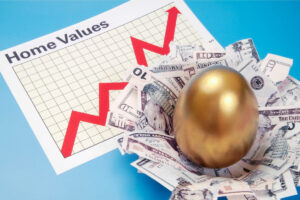Strategic Pricing: How to Set the Right Price for Your Home and Boost Your Chances of a Fast Sale
Strategic Pricing: How to Set the Right Price for Your Home and Boost Your Chances of a Fast Sale
When selling your home, few decisions are as crucial as setting the right price. A well-thought-out pricing strategy can significantly increase your chances of a quick sale and maximize your profit. However, determining the perfect price for your property is not always easy, as it requires a thorough understanding of the current market conditions, local trends, and an evaluation of comparable sales.
This comprehensive guide will walk you through the strategic pricing process, providing valuable insights and practical tips to help you set the right price for your home and ultimately boost your chances of a fast sale.
Understanding the Importance of Strategic Pricing
Strategic pricing is essential to the success of your home sale. When a property is priced correctly, it attracts the right buyers and encourages competitive offers. Conversely, if a home is overpriced or underpriced, it can lead to a prolonged sales process, reducing the likelihood of receiving multiple offers and potentially decreasing the final sales price.
Here are a few reasons why strategic pricing is critical:
A. Attracting the Right Buyers: Accurately priced homes draw in interested and qualified buyers, leading to more showings and, ultimately, more offers.
B. Encouraging Competitive Offers: When a property is priced correctly, it can create a sense of urgency among buyers, encouraging them to submit their best offers and increasing the chances of a bidding war.
C. Reducing Time on the Market: Homes that are priced well tend to sell faster, reducing the carrying costs associated with a prolonged sales process.
D. Protecting Your Home’s Value: An overpriced property can discourage potential buyers, causing your home to sit on the market and ultimately sell for less than its true value.
The Foundation of Pricing Your Home
 The foundation of pricing your home lies in understanding its true market value. Market value is the amount a willing buyer would pay a willing seller for a property, considering all relevant factors. To determine the market value of your home, you need to take into account several factors, including:
The foundation of pricing your home lies in understanding its true market value. Market value is the amount a willing buyer would pay a willing seller for a property, considering all relevant factors. To determine the market value of your home, you need to take into account several factors, including:
A. Location
Your home’s location is one of the most significant factors affecting its value. Homes in desirable neighborhoods or near sought-after amenities tend to have higher values.
B. Size and Layout
The size of your home, including the number of bedrooms, bathrooms, and overall square footage, will affect its value. Additionally, the layout and flow of the floor plan can influence how buyers perceive the space.
C. Condition and Upgrades
The overall condition of your home and any upgrades or improvements made can also impact its value. Well-maintained properties with updated features tend to be more attractive to buyers and command higher prices.
D. Market Conditions
The current state of the local real estate market plays a crucial role in determining your home’s value. Housing inventory, buyer demand, and interest rates can influence property values.
Analyzing the Current Market
A deep understanding of the current market conditions is essential for setting the right price for your home. Market conditions can be categorized as seller’s, buyer’s, or balanced markets. Each of these scenarios has unique characteristics that influence pricing strategies.
A. Seller’s Market
A seller’s market occurs when there is high home demand and low inventory. In this situation, sellers have the upper hand as buyers compete for limited available properties. This often leads to higher sale prices and faster sales.
B. Buyer’s Market
A buyer’s market is characterized by a surplus of homes for sale and low buyer demand. In this scenario, buyers have more choices and negotiating power, resulting in lower sale prices and longer time on the market for sellers.
C. Balanced Market
A balanced market is a relatively even match between supply and demand. In this situation, neither buyers nor sellers have a distinct advantage, and properties tend to sell at a reasonable pace and for a fair price.
To analyze the current market, consider the following factors:
- Inventory Levels: Research the number of homes currently for sale in your area and compare it to historical trends. High inventory levels indicate a buyer’s market, while low inventory levels suggest a seller’s market.
- Days on Market (DOM): The average number of days it takes for a property to sell can provide insight into the current market conditions. A low DOM indicates a strong seller’s market, while a high DOM suggests a buyer’s market.
- Sale-to-List Price Ratio: The sale-to-list price ratio is the final sale price of a home divided by its original list price. A high proportion (above 100%) indicates a seller’s market, while a low ratio (below 100%) suggests a buyer’s market.
- Mortgage Rates: Monitor mortgage rates, as they can influence buyer demand. Lower interest rates can increase buyer demand and lead to a more competitive market, while higher rates can have the opposite effect.
- Local Economic Factors: Be aware of local economic factors impacting the real estate market, such as job growth, new developments, and infrastructure changes.
Once you understand the current market conditions, you can make more informed decisions about your home’s pricing strategy.
Evaluating Comparable Sales
One of the most reliable methods for determining the right price for your home is to evaluate comparable sales or “comps.” Comps are recently sold properties in your area with similar features, sizes, and conditions to your home. By analyzing comps, you can better understand how the market values properties like yours and set a price that reflects its true value.
To evaluate comparable sales, consider the following steps:
- Identify Relevant Comps: Look for properties that have sold within the last three to six months, within a close radius (typically 0.5 to 1 mile) of your home, and have similar characteristics, such as age, size, and layout.
- Adjust for Differences: Account for significant differences between your home and the comps, such as upgrades, lot size, or unique features. This may require adding or subtracting value based on these differences’ impact on a property’s market value.
- Analyze Sale Prices: Calculate the average sale price of the comps and compare it to your home’s estimated value. Use this information to help guide your pricing strategy.
- Monitor Active Listings: Monitor active listings in your area to understand how your competition is pricing their homes. This can help determine whether your pricing strategy aligns with the current market.
Remember that evaluating comparable sales is an ongoing process As new properties sell and the market changes.
The Role of Timing in Pricing
 While market conditions and comparable sales play a significant role in determining the right price for your home, timing is another essential factor to consider. The real estate market can fluctuate throughout the year, with certain times being more favorable for sellers than others. By understanding these trends and adjusting your pricing strategy accordingly, you can maximize your home’s value and increase your chances of a quick sale.
While market conditions and comparable sales play a significant role in determining the right price for your home, timing is another essential factor to consider. The real estate market can fluctuate throughout the year, with certain times being more favorable for sellers than others. By understanding these trends and adjusting your pricing strategy accordingly, you can maximize your home’s value and increase your chances of a quick sale.
Here are some aspects of timing that can impact your home pricing strategy:
A. Seasonal Trends: The real estate market often experiences seasonal fluctuations, with certain times of the year busier than others. In many regions, the spring and early summer months tend to be the most active, as buyers are eager to move before the start of the new school year. During these peak seasons, you may be able to price your home slightly higher due to increased demand. Conversely, during slower periods, such as the winter months, you may need to be more conservative with your pricing to attract buyers.
B. Local Events and Developments: Monitor local events and developments that could impact the real estate market. For example, opening a new school or business can increase demand in the area, potentially allowing you to price your home more aggressively. On the other hand, negative events or developments, such as plant closures or increases in crime rates, may necessitate a more cautious pricing approach.
C. Economic Factors: Broader economic factors, such as job growth, consumer confidence, and mortgage interest rates, can also influence the real estate market. For instance, buyers may be more willing to pay higher prices during periods of strong economic growth and low interest rates. In contrast, buyers may become more price-sensitive during economic downturns or rising interest rates.
D. Personal Circumstances: Your situation can also affect your pricing strategy. If you are in a hurry to sell your home due to a job relocation, divorce, or other pressing circumstances, you may need to price your house more competitively to encourage a quick sale. Conversely, if you have more flexibility with your timeline, you can potentially hold out for a higher price.
To maximize the timing of your home’s pricing, stay informed about local, regional, and national real estate trends and any personal factors that may impact your sale. Use this information to adjust your pricing strategy as needed, ensuring that your home is positioned to attract the right buyers at the right time.
Factors Affecting Your Home’s Value
Several factors can affect your home’s value, both positively and negatively. Understanding these factors is crucial when determining the right price for your property.
Here are some key factors to consider when assessing your home’s value:
A. Location: As the adage goes, “location, location, location.” The desirability of your home’s location can significantly impact its value. Factors such as proximity to schools, parks, shopping centers, and public transportation can all contribute to your home’s appeal. Additionally, the overall reputation and safety of your neighborhood can also influence your property’s value.
B. Size and Layout: The size of your home, including square footage, the number of bedrooms and bathrooms, and the size of the lot, can all affect its value. In general, larger homes with more bedrooms and bathrooms are worth more. Additionally, the layout and flow of your home can impact its perceived value. Open floor plans, functional spaces, and ample storage are all features that buyers typically find attractive.
C. Condition and Maintenance: Your home’s overall condition can play a significant role in determining its value. Well-maintained properties with updated systems (such as HVAC, plumbing, and electrical) and a clean, move-in-ready appearance are more appealing to buyers and can command higher prices. In contrast, homes with deferred maintenance or outdated features may need to be priced lower to account for the cost of necessary repairs or updates.
D. Upgrades and Improvements: Upgrades and improvements can add value to your home, particularly if they align with current buyer preferences. However, it is essential to remember that not all upgrades will result in a dollar-for-dollar increase in your home’s value. Some projects, such as kitchen and bathroom renovations, typically have a higher return on investment (ROI) than others.
E. Age and Architectural Style: Your home’s age and architectural style can also influence its value. Newer homes may command higher prices due to modern features, energy efficiency, and lower maintenance requirements. Conversely, older homes with unique architectural styles or historical significance can also be highly desirable and valuable, particularly if they have been well-maintained and updated.
F. Market Conditions: As discussed earlier, the current state of the real estate market can significantly impact your home’s value. Factors such as housing inventory, buyer demand, and interest rates can all influence property values.
G. External Factors: External factors can also affect your home’s value, including environmental factors (such as flood zones, noise pollution, or proximity to industrial areas), local government policies, and economic conditions.
When determining the right price for your home, it is essential to consider all these factors. Objectively assess your property’s strengths and weaknesses and adjust your pricing strategy accordingly. Additionally, working with a knowledgeable real estate agent can help you better understand how these factors affect your home’s value and guide you in setting the right price.
Pricing Strategies for Different Market Conditions
 Your pricing strategy should be tailored to the current market conditions to maximize your chances of a fast sale and the best possible price. Here are some pricing strategies for different market conditions:
Your pricing strategy should be tailored to the current market conditions to maximize your chances of a fast sale and the best possible price. Here are some pricing strategies for different market conditions:
A. Seller’s Market Pricing Strategy:
In a seller’s market, where demand and inventory are low, you can typically price your home more aggressively. The competition among buyers can lead to multiple offers and even bidding wars, driving up the final sale price. Consider these strategies in a seller’s market:
- Price at or slightly above market value:
- Since buyers compete for limited inventory, pricing your home at or slightly above market value can help generate interest and potentially multiple offers.
- Offer incentives: While not directly related to pricing, offering incentives like covering closing costs or including a home warranty can make your property even more attractive to buyers.
- Be prepared to negotiate: Even in a seller’s market, it’s essential to be open to negotiation. Listen to buyer feedback and be willing to adjust your price or offer concessions if necessary.
B. Buyer’s Market Pricing Strategy:
In a buyer’s market, where there is an excess of homes for sale and buyer demand is low, you may need to be more conservative with your pricing strategy to attract buyers. Consider these strategies in a buyer’s market:
- Price slightly below market value: To make your home stand out from the competition, consider pricing it below market value. This can attract more buyers and potentially lead to a quicker sale.
- Offer flexibility: To make your home more appealing in a competitive market, be open to buyer requests, such as flexible closing dates or rent-back agreements.
- Be prepared to make adjustments: In a buyer’s market, it’s important to closely monitor your home’s performance and be designed to make price adjustments if it isn’t attracting enough interest.
C. Balanced Market Pricing Strategy:
A fair pricing strategy is key in a balanced market, where supply and demand are relatively even. Consider these strategies in a flat market:
- Price at market value: Research comparable sales and price your home at its true market value to attract the right buyers and encourage competitive offers.
- Focus on presentation: Make sure your home is well-prepared for showings, with professional photos, staging, and curb appeal to stand out.
- Be patient: In a balanced market, homes may take longer to sell than in a seller’s market. Be patient and stay open to feedback from buyers and agents.
Regardless of market conditions, it is crucial to work closely with a knowledgeable real estate agent who can help you determine the right pricing strategy for your situation. Review your home’s performance on the market regularly and be prepared to adjust your pricing strategy as needed.
The Psychology of Pricing
Pricing a home is not just about numbers and market conditions; it’s also about understanding buyers’ psychology and how they perceive the value of a property.
Here are some key psychological factors to consider when setting the right price for your home:
A. Anchoring: The anchoring effect refers to people’s tendency to rely heavily on the first piece of information they receive when making a decision. When pricing your home, the initial asking price can set the anchor for potential buyers, influencing their perception of its value. Therefore, it’s important to select the right initial asking price that reflects the true market value of your home.
B. Framing refers to how information is presented and can significantly impact how buyers perceive a property’s value. For example, giving your home as a “move-in-ready” property with updated features can create a positive frame that enhances its perceived value. Alternatively, emphasizing potential issues or deficiencies can create a negative structure that lowers its perceived value.
C. The Contrast Effect: The contrast effect occurs when people perceive an object as more or less valuable depending on the context in which it is presented. For example, suppose a buyer sees a property with a higher price tag immediately before viewing your home. In that case, they may perceive your home as less valuable in comparison, even if it is priced fairly.
D. Scarcity: The scarcity principle suggests that people place a higher value on things perceived as rare or scarce. You can leverage this principle by creating a sense of urgency through limited-time offers, deadlines, or multiple offers. This can make sense of buyer competition and potentially lead to higher sale prices.
E. Emotion: Finally, it’s important to recognize the emotional component of buying a home. People often make decisions based on their feelings rather than pure logic. Creating an emotional connection with potential buyers through effective staging, personal touches, and highlighting the property’s unique features can increase its perceived value.
Incorporating these psychological factors into your pricing strategy can help you positively perceive your home’s value and maximize its sale price. Work with a knowledgeable real estate agent who can help you identify the most effective tactics for your specific situation.
Common Pricing Mistakes to Avoid
When pricing your home, sellers can make several common mistakes that lead to a longer time on the market or a lower sale price than expected.
Here are some pricing mistakes to avoid:
A. Overpricing: Many sellers make the common mistake of overpricing. While it may seem tempting to price your home high and see what offers come in, an overpriced home can sit on the market for months without generating interest. To avoid this mistake, research comparable sales in your area and set a realistic price that reflects the current market conditions.
B. Ignoring Market Trends: As discussed earlier, market conditions can significantly impact your home’s value. Ignoring these trends and pricing your home based on personal preference or emotion rather than market conditions can lead to a pricing mismatch that can turn off potential buyers.
C. Ignoring Feedback: Feedback from buyers and agents can be valuable in adjusting your pricing strategy. Ignoring this feedback or failing to change your price accordingly can lead to a longer time on the market and a lower sale price.
D. Failing to Adjust Pricing Strategy: Real estate markets can change rapidly, and failing to adjust your pricing strategy accordingly can lead to missed opportunities. It’s essential to keep an eye on the market and adjust your price to stay competitive and attract potential buyers.
E. Focusing Only on Price: While price is essential when selling your home, it’s not the only one. Focusing solely on merit and neglecting other aspects, such as presentation and marketing, can also hurt your chances of a successful sale.
To avoid these common pricing mistakes, work closely with a knowledgeable real estate agent who can help you navigate the market and develop a pricing strategy that reflects the current conditions and meets your goals. Regularly monitor your home’s performance on the market and be open to feedback and adjustments as needed.
Adjusting Your Price When Necessary
If your home isn’t generating enough interest or offers, it may be time to consider adjusting your price. While it can be challenging to lower your asking price, doing so can help your property stand out in a competitive market and potentially lead to a faster sale.
Here are some tips for adjusting your price when necessary:
A. Monitor Market Trends: Monitor current market trends and how they impact the sale of homes in your area. If you notice a shift in the market or a change in buyer behavior, it may be time to consider a price adjustment.
B. Review Feedback: Feedback from potential buyers and their agents can provide valuable insights into how your home is perceived. Review this feedback regularly and look for patterns or common themes that may indicate a need for a price adjustment.
C. Compare to Comparable Sales: Regularly compare your home to comparable sales in your area to determine if your asking price aligns with market conditions. If similar homes sell for less than your asking price, it may be time to adjust your price.
D. Be Realistic: While it can be difficult to lower your asking price, it’s important to be realistic about your home’s value in the current market. An overpriced home can sit on the market for months, ultimately leading to a lower sale price than if it had been priced correctly from the start.
E. Timing: Timing is crucial when adjusting your price. Consider changing your price after some time has passed without interest or after receiving feedback from buyers or agents. Be prepared to adjust your price quickly, if necessary, to take advantage of any changes in market conditions.
F. Work with Your Agent: Your real estate agent can be valuable in determining when and how to adjust your price. Work closely with them to develop a pricing strategy that reflects the current market conditions and meets your goals.
Adjusting your price can be difficult, but ensuring a successful sale is often necessary. By regularly monitoring market trends, reviewing feedback, and working closely with your agent, you can develop a pricing strategy that meets your goals and maximizes your chances of a successful sale.
Final Thoughts
Pricing your home correctly is crucial to a successful sale. By considering market conditions, understanding the psychology of buyers, and working with a knowledgeable real estate agent, you can develop a pricing strategy that reflects the true value of your home and attracts potential buyers.
Remember to be realistic about your home’s value and open to adjustments. Monitor current market trends, listen to feedback from potential buyers and agents, and work closely with your agent to develop a pricing strategy that meets your goals.
Selling a home can be complex, but with the right pricing strategy and support, you can achieve a successful sale and move on to your next adventure.
To learn more details, let’s talk with Amar REALTOR®
Let’s schedule a meeting to review all your Real Estate goals!
![]()
Please Click to schedule a time on my online calendar at no cost!
https://www.amarrealtor.com/meetingwithamarrealtor/
Contact Amar REALTOR® today for more information about Buying/Selling a Home in the Bay Area!
Amar REALTOR® offers expert real estate services with proven results in the Bay Area Housing Market, including Homes for sale in Santa Clara County, San Mateo County, Contra Costa County, and Alameda County.
More Interesting Information about Bay-Area Real Estate
First-Time Homebuyers: Buying A Historic Home Here’s What You’ll Need To Know?
First-Time Homebuyers: All About Foreclosures
